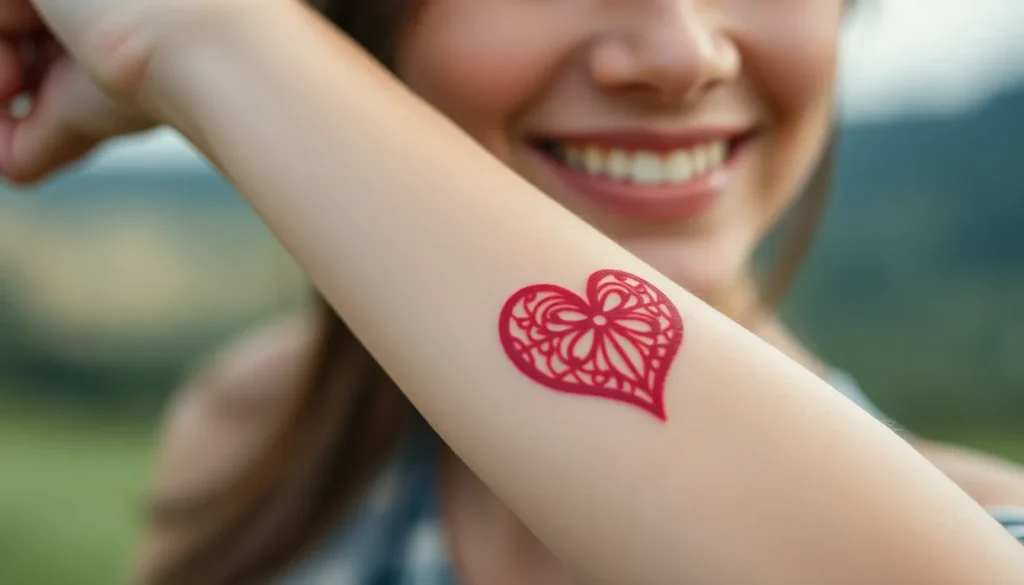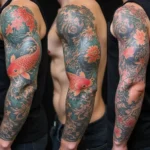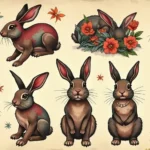Heart tattoos have captured our collective imagination for decades, becoming one of the most beloved and timeless tattoo designs worldwide. Whether you’re considering your first tattoo or adding to your existing collection, understanding the rich symbolism behind heart tattoos can help you make a meaningful choice that resonates with your personal story.
We’ve all seen heart tattoos in countless variations – from simple black outlines to elaborate designs filled with vibrant colors, names, or intricate details. But what makes these designs so universally appealing? The answer lies in their incredible versatility and deep emotional significance.
Beyond their obvious association with love and romance, heart tattoos carry layers of meaning that might surprise you. They can represent everything from spiritual devotion and family bonds to personal transformation and healing. Let’s explore the intriguing area of heart tattoo symbolism and discover why this iconic design continues to speak to people across all walks of life.
Historical Origins of Heart Tattoo Symbolism
Heart tattoos trace their origins back to ancient civilizations where the heart symbol represented life force and spiritual connection. Ancient Egyptians documented heart imagery in religious texts around 3000 BCE, associating the organ with the soul’s eternal journey. Roman soldiers carved heart shapes into shields and armor, believing these symbols provided protection during battle.
Medieval European cultures transformed heart symbolism into representations of divine love and religious devotion. Christian iconography from the 12th century featured sacred hearts in illuminated manuscripts and cathedral artwork. Courtly love traditions during this period elevated the heart symbol as an emblem of romantic passion and chivalry.
Maritime tattoo culture popularized heart designs among sailors in the 18th and 19th centuries. Seafarers chose heart tattoos to commemorate loved ones left behind during long voyages. These early nautical heart tattoos often included banners with names, anchors, or swallows to enhance their personal meaning.
Traditional American tattooing cemented heart imagery as a cornerstone design in the early 1900s. Tattoo pioneers like Norman Collins created iconic heart styles featuring bold outlines, red shading, and decorative elements. Military personnel during Industry Wars I and II frequently selected heart tattoos to honor sweethearts and fallen comrades.
Cultural variations of heart symbolism emerged across different societies throughout history. Japanese culture associated heart imagery with compassion and emotional balance in traditional art forms. Celtic traditions incorporated heart knots and interwoven patterns to represent eternal bonds and ancestral connections.
The evolution of heart tattoo symbolism reflects humanity’s universal need to express love, loss, and loyalty through permanent body art. Modern heart tattoo designs continue building upon these historical foundations while incorporating contemporary artistic techniques and personal interpretations.
Traditional Heart Tattoo Meanings

Traditional heart tattoo designs carry exact symbolic meanings that have remained consistent across cultures and generations. These classic interpretations form the foundation of heart tattoo symbolism in contemporary body art.
Love and Romance
Love represents the most recognized meaning behind heart tattoos across all traditional designs. Classic red heart tattoos symbolize romantic affection between partners and express deep emotional connections that transcend temporary relationships. Banner heart tattoos featuring names demonstrate commitment to exact individuals and serve as permanent declarations of romantic devotion.
Couples frequently choose matching heart tattoos to represent their unified bond and shared journey through life together. Simple heart outlines communicate pure love without additional complexity while detailed anatomical hearts express more intense romantic feelings. Traditional heart and arrow designs indicate being struck by love and capture the moment of romantic awakening.
Passion and Devotion
Passion extends beyond romantic love to cover fierce dedication and unwavering commitment to beliefs or causes. Flaming heart tattoos represent burning passion that consumes the individual and drives their actions with intense energy. Sacred heart designs demonstrate religious devotion and spiritual commitment to divine principles.
Heart tattoos with thorns or barbed wire symbolize passionate love that comes with pain and sacrifice. Winged heart designs represent passionate freedom and the elevation of love above earthly concerns. Traditional sailor heart tattoos expressed devotion to homeland and family during long voyages at sea.
Loss and Memorial
Memorial heart tattoos honor deceased loved ones and preserve their memory through permanent body art. Broken heart designs represent grief and the pain of separation from those who have passed away. Heart tattoos incorporating names and dates create lasting tributes to exact individuals who impacted the wearer’s life.
Black heart tattoos symbolize mourning and the emptiness felt after important loss. Angel wings combined with heart imagery represent the deceased’s spiritual journey and continued presence in the wearer’s life. Traditional memorial hearts often include roses or other flowers that represent the beauty of remembered love even though death’s finality.
Popular Heart Tattoo Variations and Their Meanings
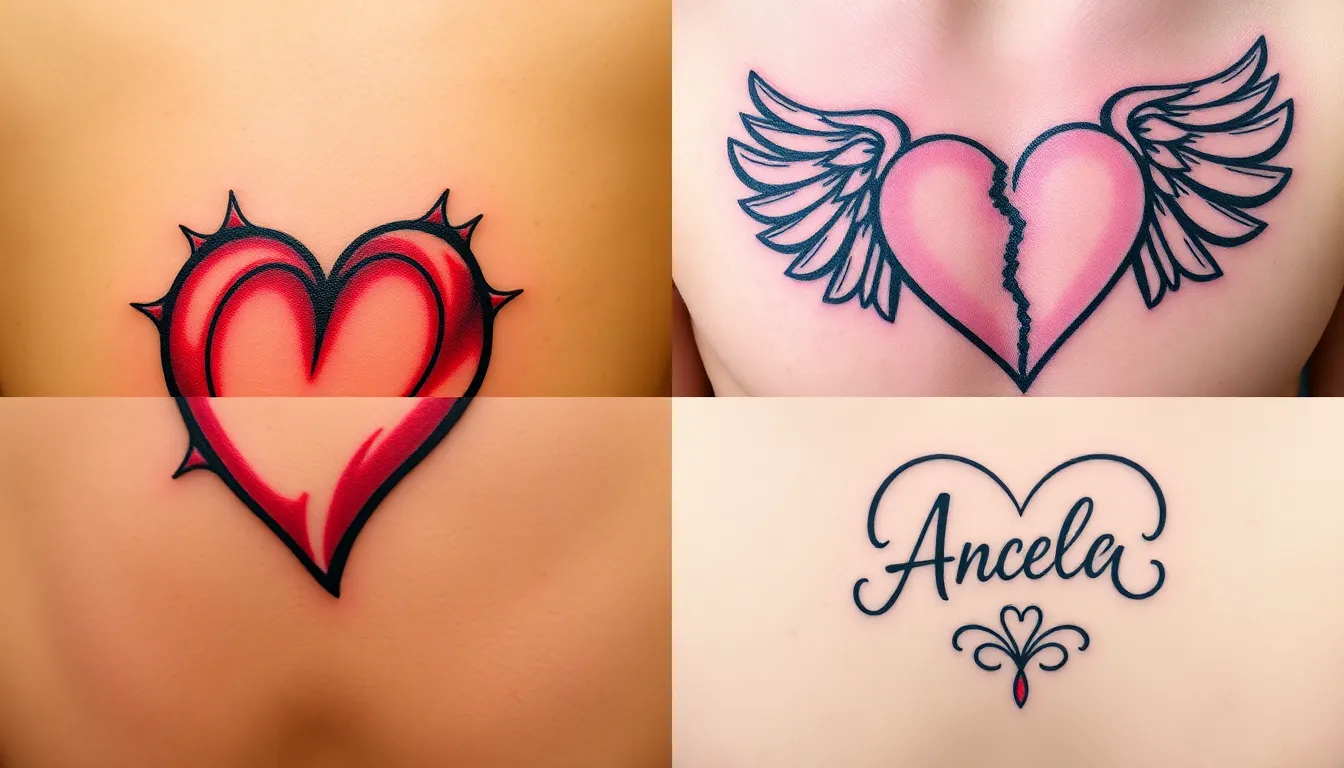
Heart tattoo variations offer unique symbolic interpretations that extend far beyond basic love symbolism. Each design carries distinct meanings that reflect personal experiences, spiritual beliefs, and emotional connections.
Sacred Heart Tattoos
Sacred heart tattoos represent divine love and spiritual devotion within Christian symbolism. These designs feature a heart surrounded by thorns, flames, or a crown, often depicting the Sacred Heart of Jesus. Religious individuals choose sacred heart tattoos to express their faith and connection to divine compassion. The thorns symbolize suffering and sacrifice, while flames represent purification and burning love for God. Catholic communities particularly embrace these designs as permanent expressions of religious commitment. Modern interpretations incorporate colorful roses, crosses, or prayer hands alongside the sacred heart imagery.
Broken Heart Tattoos
Broken heart tattoos symbolize emotional pain, loss, and personal healing journeys. These designs typically feature cracked or shattered heart imagery, representing experiences with heartbreak, betrayal, or grief. People choose broken heart tattoos to commemorate difficult relationships, honor deceased loved ones, or mark important life transitions. Cracks often appear as jagged lines through the heart center, while some designs include bandages or stitches to represent healing processes. Black ink dominates most broken heart tattoos, though some individuals incorporate red accents to highlight emotional intensity. These tattoos serve as permanent reminders of resilience and personal growth through adversity.
Heart with Wings Tattoos
Heart with wings tattoos represent freedom, transformation, and elevated love that transcends earthly boundaries. Wings symbolize liberation from emotional constraints and spiritual ascension beyond physical limitations. Memorial versions honor deceased loved ones by suggesting their spirits remain free and watchful. Angel wings paired with hearts indicate protection and divine guidance in relationships. Butterfly wings combined with heart imagery represent personal transformation and emotional metamorphosis. Bird wings express the desire for relationships that soar above mundane concerns and embrace higher spiritual connections.
Heart with Names or Initials
Heart with names or initials tattoos create permanent tributes to important people in our lives. These designs feature names, dates, or initials integrated within or around heart imagery. Parents frequently choose these tattoos to honor children, incorporating birth dates alongside names. Couples select matching name tattoos to symbolize eternal commitment and shared identity. Memorial versions commemorate deceased family members or friends through elegant script lettering. Banner designs wrap names around heart shapes, creating classic tattoo aesthetics reminiscent of traditional American tattooing. Script fonts range from elegant cursive to bold block letters, depending on personal preferences and available space.
Cultural Interpretations Across Different Societies
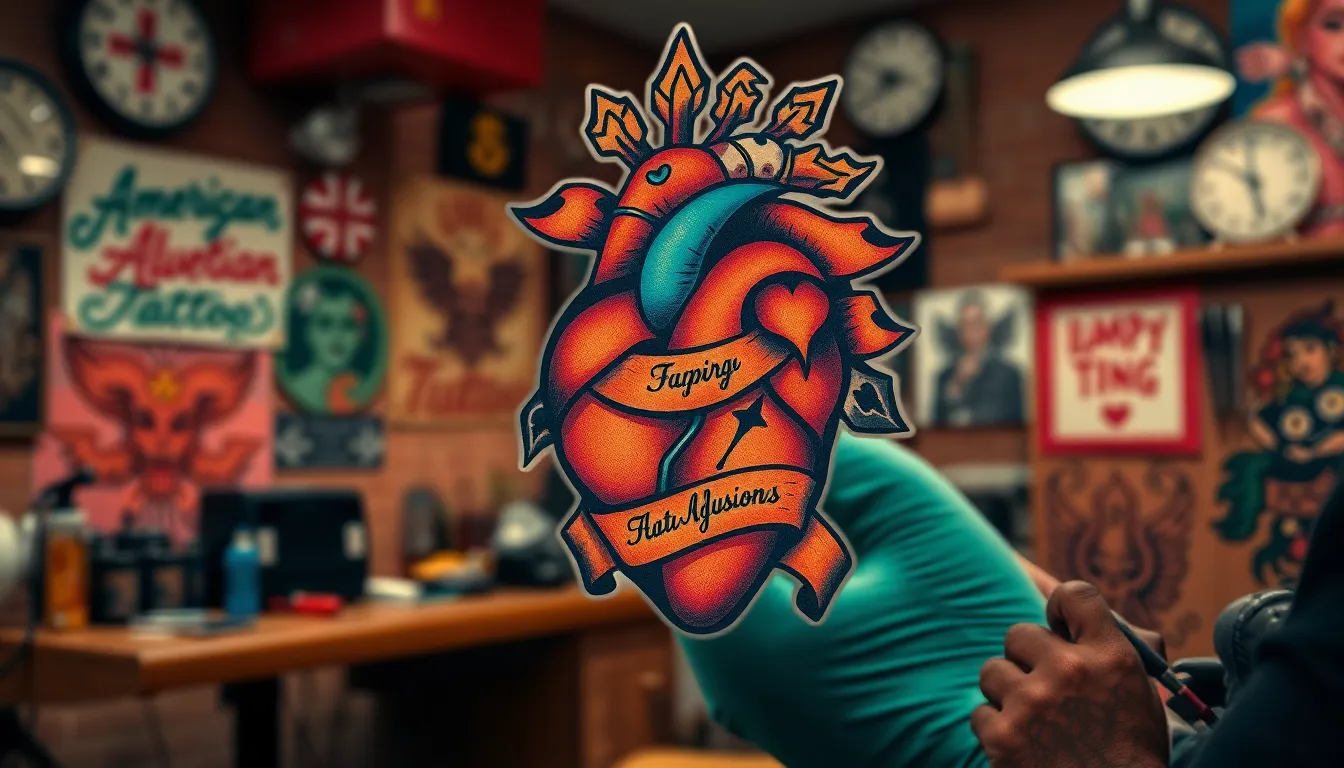
Cultural interpretations of heart tattoos vary dramatically across societies, with each region bringing unique perspectives to this universal symbol. Eastern cultures often emphasize spiritual dimensions, while Western societies typically focus on romantic connections.
Eastern Cultural Perspectives
Japanese culture associates heart imagery with compassion and empathy, reflecting Buddhist teachings about loving-kindness toward all beings. Heart tattoos in Japan frequently incorporate cherry blossoms or koi fish to represent the impermanence of life and emotional growth. Chinese interpretations link heart symbols to the concept of “xin” (心), representing both the physical heart and the mind’s emotional center.
Hindu traditions view heart tattoos as representations of the Anahata chakra, symbolizing unconditional love and spiritual balance. Sanskrit mantras often accompany heart designs to enhance their spiritual significance. Korean culture connects heart symbols to “jeong” (정), describing deep emotional bonds between family members and close friends.
Western Cultural Traditions
European interpretations of heart tattoos stem from medieval courtly love traditions and Christian symbolism. Celtic heart designs incorporate knotwork patterns to represent eternal bonds and unbreakable connections. Irish Claddagh hearts combine loyalty, friendship, and love in a single meaningful design.
American tattoo culture transformed heart symbols into bold statements of personal identity and emotional expression. Traditional American heart tattoos feature bright colors and banner scrolls, creating iconic designs that celebrate love and loss. Latino communities often incorporate religious elements like roses or crosses with heart tattoos to honor family devotion.
| Culture | Primary Meaning | Common Design Elements |
|---|---|---|
| Japanese | Compassion | Cherry blossoms, koi fish |
| Chinese | Mind-heart connection | Calligraphy, dragons |
| Hindu | Spiritual chakra | Sanskrit symbols, lotus |
| Celtic | Eternal bonds | Knotwork, spirals |
| American | Personal identity | Banners, bold colors |
| Latino | Family devotion | Roses, religious symbols |
Indigenous and Tribal Interpretations
Native American tribes view heart symbols as connections to Mother Earth and ancestral spirits. Heart tattoos often incorporate feathers, dreamcatchers, or animal totems to strengthen these spiritual bonds. Polynesian cultures embed heart motifs within larger tribal patterns, representing family lineage and community connections.
African tribal traditions associate heart imagery with life force energy and tribal unity. Heart designs frequently combine with geometric patterns or animal symbols to create powerful statements of cultural identity. Australian Aboriginal interpretations connect heart symbols to songlines and dreamtime stories.
Modern Global Fusion
Contemporary tattoo culture blends various cultural interpretations to create personalized heart designs that honor multiple traditions. Fusion styles combine Eastern spiritual elements with Western romantic symbolism, resulting in unique artistic expressions. Cross-cultural marriages often inspire heart tattoos that represent the merging of different cultural backgrounds.
Modern artists incorporate traditional elements from various societies to create respectful homages to cultural heritage. Heart tattoos serve as bridges between cultures, allowing individuals to express their multicultural identities through meaningful body art.
Modern Heart Tattoo Trends and Contemporary Meanings
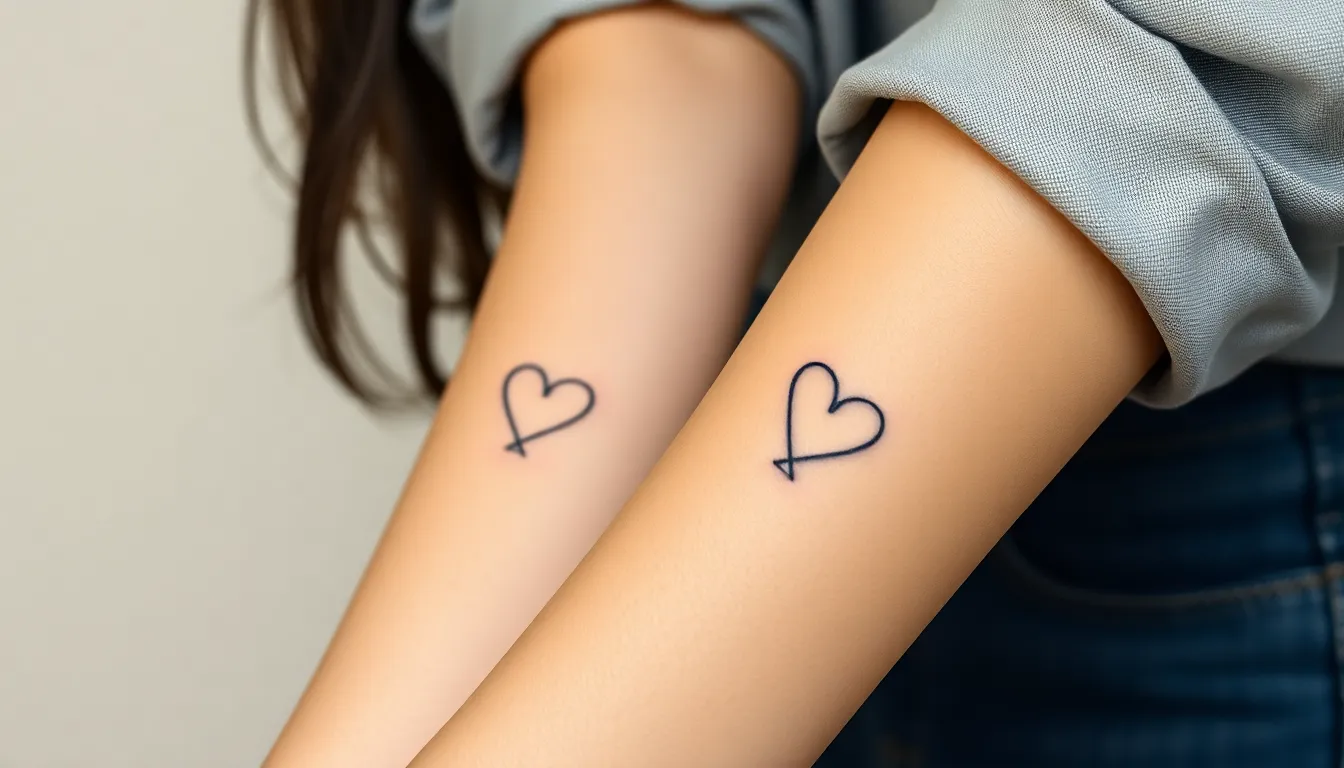
Contemporary heart tattoo designs reflect evolving artistic preferences and personal expression methods in today’s tattoo culture. Modern interpretations blend traditional symbolism with innovative artistic techniques to create meaningful body art.
Minimalist Heart Designs
Minimalist heart tattoos emphasize clean lines and simple geometric shapes to convey powerful emotional messages. Fine line techniques create delicate outlines that appeal to clients seeking subtle yet meaningful designs. These streamlined interpretations often measure between 1-3 inches and feature single-needle work for precise detailing.
Single outline hearts represent pure love without additional embellishments or decorative elements. Geometric heart variations incorporate triangular shapes and angular lines to modernize the classic symbol. Watercolor accents add soft color washes to minimalist frameworks while maintaining the design’s understated aesthetic.
Placement options for minimalist hearts include wrists, ankles, behind ears, and fingers where small designs create intimate personal statements. Negative space techniques use skin tone as part of the design composition to enhance the minimalist approach. Dotwork variations create textured hearts using stippling methods that add depth without overwhelming simplicity.
Anatomical Heart Tattoos
Anatomical heart tattoos showcase realistic medical illustrations that celebrate the body’s most vital organ. These designs feature accurate depictions of chambers, arteries, and valves to create scientifically precise representations. Medical professionals and science enthusiasts often choose anatomical hearts to honor their connection to human biology.
Detailed shading techniques bring three-dimensional depth to anatomical heart designs through realistic muscle tissue rendering. Color variations range from traditional red tones to artistic interpretations using blues, purples, and grayscale palettes. Floral elements often intertwine with anatomical structures to soften the medical imagery and add feminine touches.
Hybrid designs combine anatomical accuracy with decorative elements like roses, thorns, or geometric patterns. Size considerations for anatomical hearts typically require larger canvas areas such as forearms, calves, or back pieces to accommodate intricate details. Blackwork anatomical hearts use solid black ink to create bold contrast and dramatic visual impact.
Artist expertise becomes crucial for anatomical heart tattoos since medical accuracy requires advanced technical skills and detailed reference materials.
Placement and Size: How Location Affects Meaning
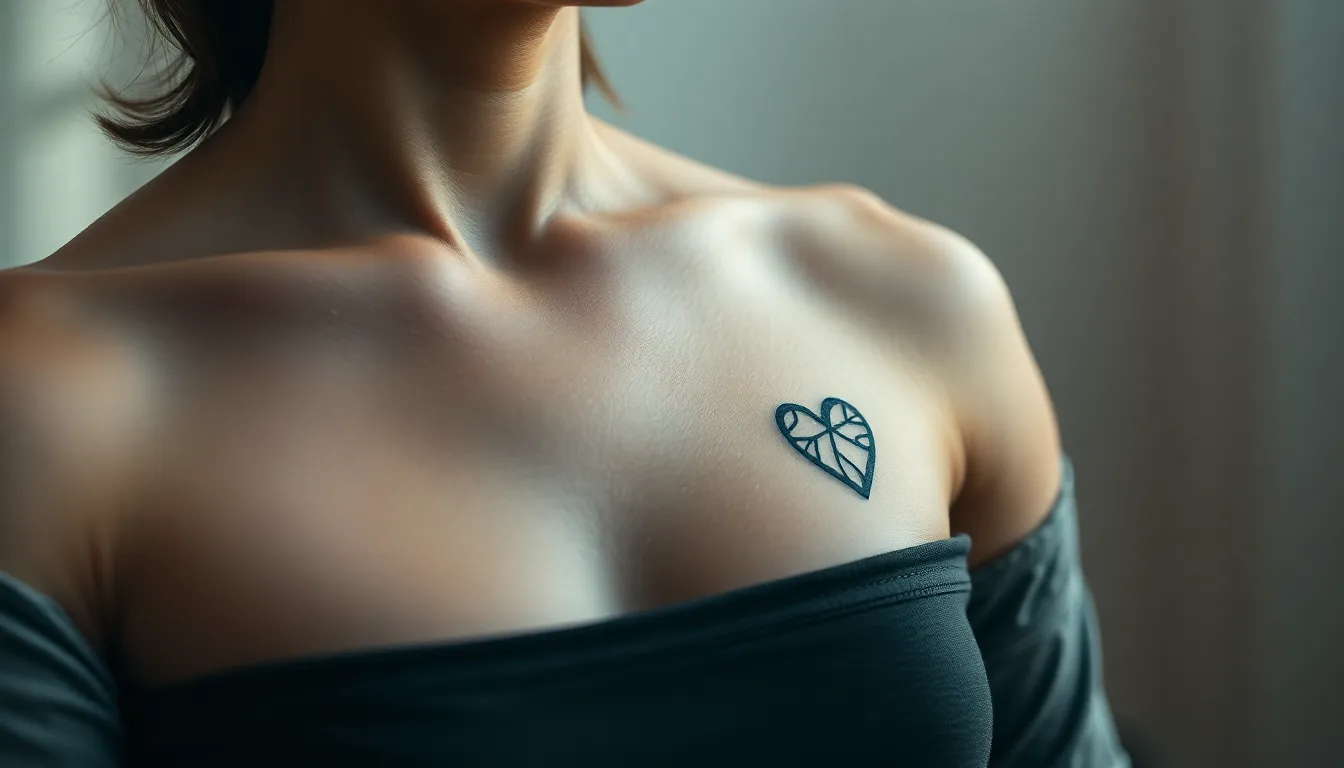
Heart tattoo placement carries profound symbolic weight that directly influences the design’s emotional impact and personal significance. We observe distinct patterns in how different body locations enhance or modify traditional heart symbolism across various cultural contexts.
Chest placement creates the most powerful connection to the heart’s natural position within our bodies. Tattoos positioned directly over the heart amplify romantic and spiritual meanings while establishing an intimate bond between the design and its anatomical counterpart. Left chest placement specifically honors loved ones by positioning their memory closest to our heartbeat.
Wrist and hand locations transform heart tattoos into visible daily reminders of important relationships and personal commitments. These placements suit minimalist designs perfectly while ensuring constant visibility throughout daily activities. Ring finger heart tattoos replace traditional wedding bands for couples seeking alternative commitment symbols.
Behind the ear positioning creates subtle yet meaningful expressions of love and devotion that remain largely private. This intimate placement appeals to individuals who prefer discrete tattoo locations while maintaining deep personal significance. The small canvas area naturally accommodates simple heart outlines and tiny decorative elements.
Ankle and foot placements connect heart symbolism with life’s journey and forward movement. These locations often feature walking or traveling themes alongside heart imagery to represent love that endures through life’s adventures. Lower body placement creates grounding energy for spiritual heart designs.
Size variations dramatically alter heart tattoo meaning and visual impact across different placement options. Large chest pieces accommodate intricate anatomical details and complex symbolic elements like sacred hearts with elaborate decorative features. These substantial designs command attention while conveying serious emotional commitments.
Medium sized hearts work effectively on forearms and shoulders where adequate space allows for text banners featuring names or meaningful phrases. This size category balances visibility with artistic detail while maintaining professional appropriateness in most workplace environments.
Micro heart tattoos excel in discrete locations like fingers or behind ears where space limitations require simplified designs. These tiny symbols pack concentrated meaning into minimal visual space while appealing to first time tattoo recipients seeking subtle body art options.
Finger placement considerations include rapid fading due to constant hand washing and daily wear patterns. We recommend discussing touch up schedules with tattoo artists when considering finger heart designs since these locations require more maintenance than other body areas.
Multiple heart combinations create constellation effects when strategically placed across different body regions. Three small hearts traveling up the wrist represent past present and future love while creating visual movement that enhances the design’s storytelling potential.
Choosing the Right Heart Tattoo for Your Story
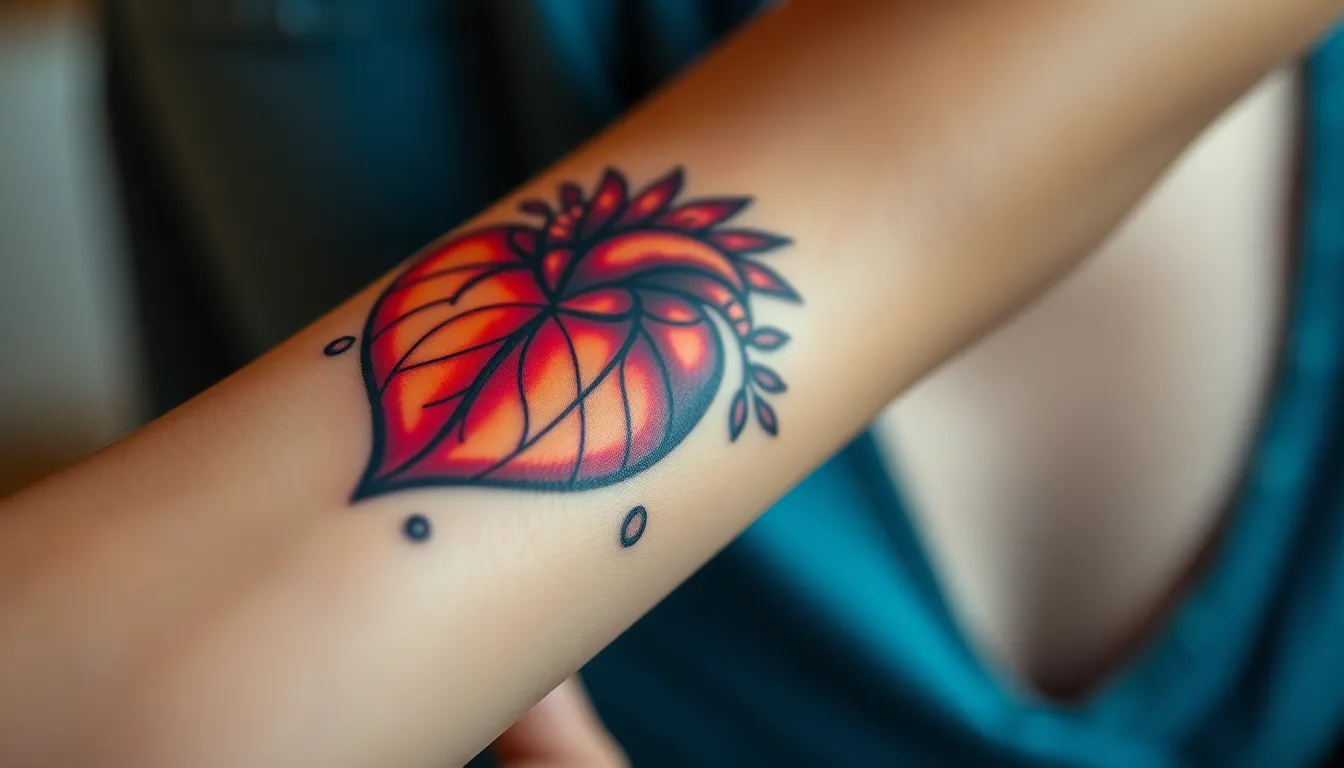
Personal narrative drives every meaningful heart tattoo selection. We consider your unique story when matching design elements to experiences that shaped you. Life events like first love, marriage, loss, or spiritual awakening guide exact symbolic choices that resonate with your journey.
Design Elements That Match Your Experience
Romantic connections call for classic red hearts with flowing banners. Sacred hearts align with spiritual devotion and religious faith. Broken heart designs represent healing from emotional trauma or grief. Anatomical hearts celebrate life-affirming experiences like recovery from illness or medical milestones.
Memorial tattoos honor deceased loved ones through black hearts or hearts with angel wings. Family bonds shine through hearts featuring children’s names or birth dates. Matching heart tattoos between partners create unified symbols of commitment.
Style Selection Based on Your Personality
Minimalist hearts suit personalities that prefer subtle expression. Geometric variations appeal to modern aesthetics and clean design preferences. Watercolor techniques attract artistic individuals who embrace creativity. Traditional American styles connect with those who appreciate classic tattoo heritage.
Intricate anatomical hearts match scientific minds or medical professionals. Floral heart combinations attract nature lovers and feminine energy. Tribal interpretations resonate with individuals honoring indigenous heritage or spiritual connections.
Size and Placement Considerations for Your Lifestyle
Professional environments influence placement decisions significantly. Wrist hearts remain visible during daily interactions. Behind-ear locations offer discretion while maintaining personal significance. Chest placements create powerful emotional connections but require clothing coverage in formal settings.
Small micro hearts work for first-time tattoo recipients or those seeking minimal commitment. Large chest pieces accommodate complex storytelling elements across broader canvas areas. Multiple heart combinations across different body regions create evolving narratives that grow with your experiences.
Career requirements, pain tolerance, and healing considerations all impact final placement choices. We evaluate these practical factors alongside emotional significance to create lasting satisfaction with your heart tattoo selection.
Conclusion
Heart tattoos remain one of the most meaningful and versatile designs in modern body art. Their rich symbolic heritage spans cultures and centuries while adapting beautifully to contemporary artistic trends and personal expression.
Whether you’re drawn to traditional romantic symbolism or modern minimalist aesthetics your heart tattoo choice reflects your unique story. The key lies in selecting elements that truly resonate with your experiences and values.
We encourage you to work closely with experienced tattoo artists who understand both the technical aspects and emotional significance of heart designs. This collaboration ensures your tattoo captures exactly what your heart means to you.
Remember that heart tattoos are timeless investments in self-expression. They’ll continue telling your story long after the ink has settled making them perfect companions for life’s journey.
Frequently Asked Questions
What do heart tattoos symbolize beyond love and romance?
Heart tattoos represent various meanings including spiritual devotion, family connections, personal transformation, healing, compassion, and memorial tributes. They can symbolize life force, soul connections, protection, and eternal bonds. Different cultures interpret heart symbols uniquely – Japanese culture associates them with compassion, while Celtic traditions view them as eternal bonds.
What are the most popular heart tattoo variations?
Popular variations include sacred heart tattoos (divine love), broken heart tattoos (emotional healing), heart with wings (freedom and transformation), anatomical hearts (realistic medical illustrations), banner hearts with names, and minimalist geometric designs. Each variation carries unique symbolic meaning and visual appeal.
How does heart tattoo placement affect its meaning?
Chest placements amplify romantic and spiritual meanings by connecting to the heart’s natural position. Wrist locations serve as visible reminders of commitments, while behind-the-ear offers discreet expression. Ankle placements symbolize life’s journey, and different sizes create varying visual impact and significance.
What’s the historical origin of heart tattoo symbolism?
Heart tattoo symbolism traces back to ancient civilizations. Egyptians associated hearts with the soul’s journey, Romans believed they provided protection, and medieval Europe connected them to divine love. Maritime culture in the 18th-19th centuries popularized heart tattoos among sailors as tributes to loved ones.
How do I choose the right heart tattoo design for my story?
Consider your personal experiences and what resonates with your story. Classic red hearts suit romantic connections, sacred hearts express spiritual devotion, and broken hearts represent healing. Factor in your lifestyle, professional environment, placement preferences, and size considerations to ensure meaningful and satisfying results.
Are heart tattoos suitable for first-time tattoo recipients?
Yes, heart tattoos are excellent for beginners due to their simple design options and universal appeal. Minimalist heart outlines are particularly suitable for first tattoos, offering clean lines and subtle meaning. They can be placed in less sensitive areas and easily concealed if needed.
What cultural variations exist in heart tattoo meanings?
Eastern cultures emphasize spiritual dimensions and compassion, while Western societies focus on romantic connections. Hindu traditions view hearts as unconditional love, Japanese culture associates them with compassion, and Indigenous interpretations link them to nature and ancestral spirits. Modern designs often blend multiple cultural elements.

